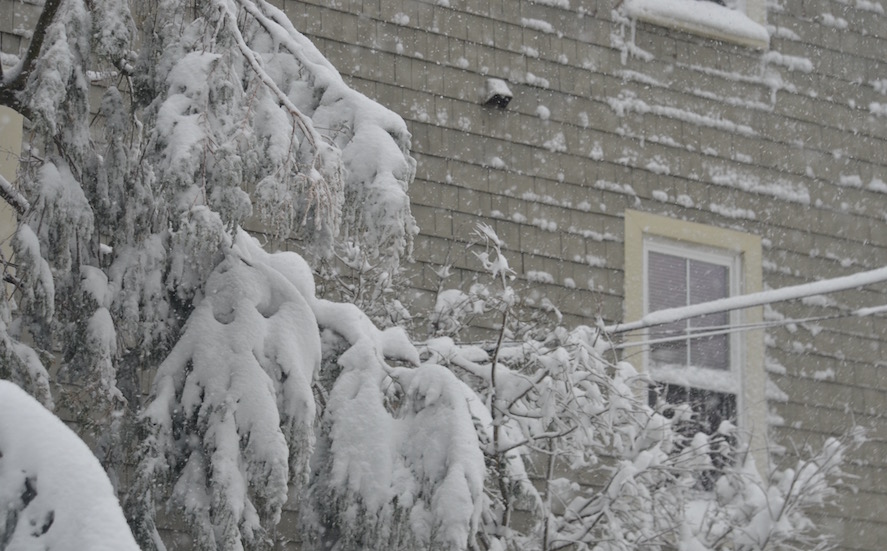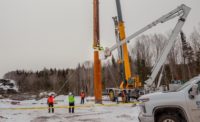In anticipation of a third powerful nor’easter in less than two weeks, construction crews in Marshfield, Mass. were working around the clock with state agencies to shore up seawalls damaged by record-high waves and tidal surges in the last two storms.
In a mile-long stretch of about 25 homes along a seawall, “we’re working as fast as we can to backshore [the seawalls], Tom Reynolds, Marshfield town superintendent said March 9. “There’s a lot erosion on the backside of the walls that has exposed them.” Underneath homes, footings for decks have all washed away, he added.
The storm is expected to bring more than a foot of heavy wet snow to the Boston region, southern New Hampshire and up to two feet in Maine and parts of Cape Cod. While power outages were restored prior to the third storm, more than 200,000 households had lost power as of 1:30 p.m. on March 13, according to the Massachusetts Emergency Management Agency. That number is expected to climb with high winds and heavy wet snow.
The March 7 storm followed an earlier storm that killed eight people and left more than 2 million people in 17 states and Washington, D.C., without power, according to the U.S. Energy Dept. The effects of the storms have been felt from Maine to Georgia. What made the first two storms unique were a series of three to four powerful tidal surges that ravaged coastal infrastructure with high waves.
In a March 13 news release, Amtrak stated it was temporarily suspending service between Boston and New York City until conditions improve. Service was also canceled on the Vermonter between St. Albans, Vt., and New York and on the Downeaster between Brunswick, Maine, and Boston.
An Amtrak spokesman said signal and catenary power outages occurred at numerous locations from Maryland to Maine. “Most of these outages were caused by trees failing into the catenary systems,” he said. Reynolds said his team was addressing seawall damage in eight Marshfield locations, including two 100-ft wall breaches, one in Green Harbor, which crews worked on between tides, and another on Ocean St. in Marshfield for which the town opened a bid on March 2 to award a $4-million seawall project.
In New Hampshire, Seabrook and Hampton reportedly sustained significant erosion from extremely high tides and Rye had seawall damage.
The cost to repair a seawall is $1,500 per linear ft and $3,500 per linear ft to replace, remove, drive sheeting and add footing for a new wall, Reynolds said.
Since the town is not repairing the Ocean Street seawall, it has placed 500 tons of armor stone and 3 to 8 tons of rocks as reinforcement until it can be replaced. The Ocean Street seawall previously breached in 2015, Reynolds said.
Similar to other New England towns, Marshfield is progressively replacing seawalls. “In the last four years, $11 million in grants and low interest loans from the state has helped,” Reynolds said. In Quincy, Mass., where more than 500 people were rescued by the police and National Guard, 2.5 miles of seawall was damaged and will cost millions to repair, New England NPR reported. Quincy Mayor Tom Kock said “Because we’re a coastal community, we’ve got 80 tide gates, we’ve got sewer pump stations, drain pump stations. So it’s complicated, and we’re trying to make sure all that infrastructure is taken care of.”
Maine has also suffered significant infrastructure damage in coastal areas. A spokesman for Maine Emergency Management Agency said the first nor’easter caused more damage from storm surge, but the second built on that. “There was some erosion and astronomically high tide, storm surge and splash over that caused a lot of infrastructure damage, especially in York County.”
Ted Talbot, spokesman for the Maine Dept. of Transportation said on March 12, “We continue to watch for coastal flooding, but [infrastructure] damage [to roadways and bridges] from the last two storms is minimal. In anticipation of 12 to 18 inches of snowfall statewide, “materials are ready, personnel are ready and we will be out for the duration of the storm.”
Unlike the prior two storms tidal surges that caused coastal infrastructure damage was not expected to be an issue in the ongoing storm, he added.





